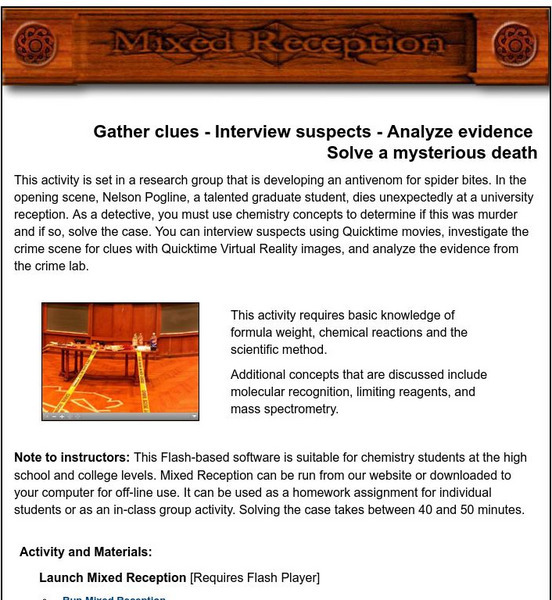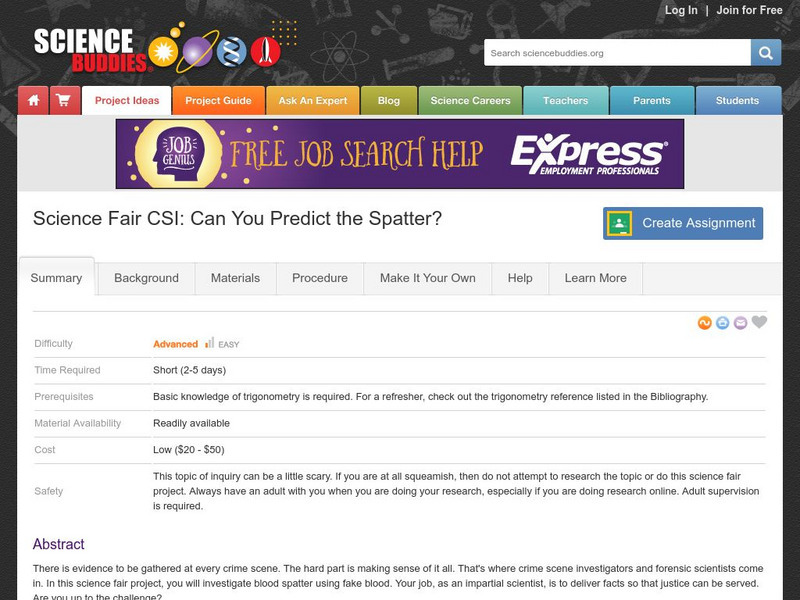Curated OER
Using Plant Pigments to Link a Suspect to a Crime
High schoolers use chromatography to separate plant pigments collected from a fictitious crime scene and suspects. They compare the Rf values of the plant pigments to determine whether the plant pigments found on any of the suspects...
Curated OER
Bloodstain Pattern Simulations: A Physical Analysis
Students receive bloodstain pattern evidence from a crime scene. They answer a series of questions through inquiry, observation, measurement, and analysis. Pupils complete this challenge, by reconstructing the evidence through four...
Curated OER
Forensics Crime Lab
Students brainstorm ways to look for evidence and investigate suspects. In this investigative lesson students pretend to be investigators and analyze a crime scene.
Curated OER
Digital Forensics
High schoolers examine a crime scene and photograph evidence. In this forensics digital photography lesson, students recognize the correct procedures for filming a crime scene. High schoolers document evidence and keep a log of the...
Curated OER
Crime Scene Documentation
Students become forensic investigators. In this crime scene instructional activity, students go to the science lab which is the "scene of the crime." They collect evidence such as fingerprints, "blood" evidence, chromatography,...
Curated OER
Who Did It?
Students explore how forensic science is used in criminal investigations. They learn that for the next few days that are going to try to solve a crime that took place in the classroom. Students are given a story to read about the crime...
Curated OER
DNA Fingerprinting
Ninth graders investigate what restriction enzymes do, and explain how a DNA sample can link a suspect to a crime.
Chemistry Collective
Chem Collective: Mixed Reception
Participate in the investigation of a virtual crime scene using chemistry concepts to solve a mysterious death. The 40-50 minute activity can be used as a classroom lab or as a homework assignment. Additionally, teachers may request a...
Science Buddies
Science Buddies: Science Fair Csi: Can You Predict the Spatter?
There is evidence to be gathered at every crime scene. The hard part is making sense of it all. That's where crime scene investigators and forensic scientists come in. In this science fair project, you will investigate blood spatter...
Science Buddies
Science Buddies: Who Done It? Dna Fingerprinting and Forensics
DNA fingerprinting (also known as DNA profile analysis and DNA typing), is a method of distinguishing between individuals by analyzing patterns in their DNA. This project focuses on the first method of DNA fingerprinting to be developed,...
Other
Science Spot: Forensic Science Lesson Plans
Huge collection of teacher-created lessons, activities, PowerPoint presentations, and worksheets for classes in forensic science.
Virginia Tech
Virginia Tech: Precision Without Accuracy in Crime Scenes
A police forensics scientist discusses how precision will muddy the true accuracy of a crime scene. Interesting stuff. A new real world look at precision and accuracy.
Other
Teachers First: Lessons: Who Did It? Forensics to Hone Science and Lab Skills
Comprehensive twenty-activity unit, complete with a WebQuest and assessment materials, designed to introduce forensic science to middle schoolers in grades 6, 7, and 8.














